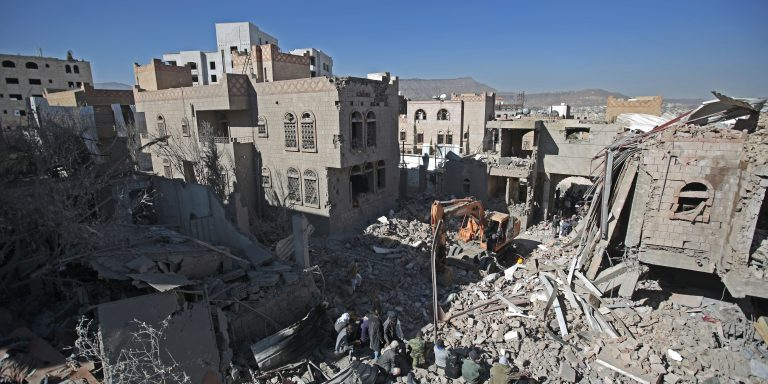
The Yemen conflict is spilling further out of the war-torn country, posing a growing threat to U.S. military personnel and citizens in the Gulf region.
The United States is sending additional forces and equipment to the United Arab Emirates (UAE) following four Houthi missile and drone attacks on the country in January.
The Houthi attacks demonstrate the growing technological capabilities and strategic reach of Iran.
A Houthi missile attack that causes U.S. military or mass civilian casualties could bring the United States into conflict with Iran or into the Yemen war directly.
For nearly seven years, the conflict between the Iran-backed Houthi movement and the Republic of Yemen Government has largely been confined to Yemen and the southern territories of Saudi Arabia, which have been targeted by Iran-supplied short-range ballistic missiles, armed drones, and cross-border rocket fire. The Yemen conflict broadened significantly since January 2022 with four Houthi-initiated missile and drone attacks on the UAE, Saudi Arabia’s main coalition partner in the Yemen war. One of the attacks, although possibly partially intercepted by U.S.-supplied missile defense systems, killed several foreign workers near Abu Dhabi international airport, a major transit hub for visitors to the Gulf and beyond. A few Houthi missile attacks on the UAE in prior years were inaccurate and landed in the desert.
In early 2022, the Yemen conflict has evolved into a direct threat to U.S. interests, U.S. military personnel, and American citizens in the Emirates, requiring defensive action by U.S. forces and U.S.-supplied sophisticated defenses. One January missile attack targeted the UAE’s sprawling Al Dhafra air base outside Abu Dhabi, where approximately 2,000 U.S. military personnel are deployed for air operations in the region, including to deter Iran and to strike Islamic State targets. The U.S. Defense Department stated: “U.S. forces at Al Dhafra Air Base… engaged two inbound missile threats with multiple Patriot interceptors coincident to efforts by the armed forces of the UAE in the early morning hours of Jan. 24, 2022. The combined efforts successfully prevented both missiles from impacting the base. There were no U.S. casualties.” However, the department acknowledged that the attack affected U.S. operations at the base, stating that the U.S. personnel went into “available bunkers” to avoid injury. Gen. Frank McKenzie, head of the U.S. military’s Central Command (CENTCOM), revealed that UAE forces used the Terminal High Altitude Area Defense (THAAD) missile defense system to intercept two of the January attacks—the first time the system has ever been fired in combat. The UAE acquired the system from the United States in 2015 to defend against Iranian missiles, not anticipating that missile attacks would come instead from one of Iran’s regional allies. Iranian leaders have transferred their missile and drone technology to allies such as the Houthis, Lebanese Hezbollah, and Iraqi Shia militias, as force multipliers that enable Tehran to project power throughout the region. Attempting to complicate U.S. military operations at Al Dhafra fits Tehran’s strategic vision, and attacking the base through one of its regional allies gives Iran a measure of deniability for the strikes.
The Houthi attacks have also interrupted U.S. efforts over the past few years to gradually redeploy some forces and equipment out of the Gulf to “pivot” to great power threats posed by Russia and China. In response to the Houthi attacks on the UAE, Defense Department press secretary John Kirby said on February 2: “[U.S. forces and equipment are] going to demonstrate… our commitment to our Emirati partners but also to be prepared to deal with very real threats that the Emiratis are under…And quite frankly, it’s not just the Emiratis, it’s our people there at Al-Dhafra too.” CENTCOM announced that the United States would deploy additional “fifth generation fighter jets” to the UAE, a reference to the F-35 Stealth Fighter or the F-22 “Raptor,” and would send the U.S.S. Cole on a mission there. The Cole has symbolic value for past involvement with Yemen; it was attacked by al-Qaeda off the coast of Yemen in October 2000, killing 17 U.S. sailors. On February 3, the U.S. announced a possible $65 million sale of parts for HAWK, Patriot, and THAAD anti-missile and air defense systems to the UAE—in part a reversal of the U.S. reduction of weapons sales and other support for the UAE and Saudi war effort in Yemen over the past few years. Reflecting its expanding security ties to the UAE, France announced that it would deploy its Rafale combat aircraft based in the UAE on “surveillance, detection and interception missions if necessary.”
Of concern to the Biden administration in the face of the broadened Houthi attacks, there are also more than 40,000 U.S. citizens living and working in the UAE. In response to the attacks, the U.S. State Department urged Americans to “reconsider travel due to the threat of missile or drone attacks.” An attack by an Iranian ally, using Iran-supplied technology, that causes large numbers of U.S. military or civilian casualties would almost certainly trigger U.S. military retaliation, potentially against Iran itself. A U.S. strike on Iran would not only risk wider regional conflict but likely also derail ongoing talks in Vienna to restore full U.S. and Iranian compliance with the 2015 multilateral Iran nuclear deal. Even as U.S. officials have prodded Saudi Arabia and the UAE to accept a compromise that ends the Yemen conflict, a mass-casualty Houthi attack on the UAE could cause the United States to enter that war directly by striking Houthi missile installations. Such an expansion again of the conflict in Yemen would, among other dire human security consequences, significantly complicate U.S. efforts to deter Russia from invading Ukraine. Beyond the geopolitical implications, further regional expansion of the war in Yemen bodes poorly for civilians in Yemen who have persevered through eight years of conflict, which has taken at least 377,000 lives and has caused the internal displacement of over 4.2 million people.
